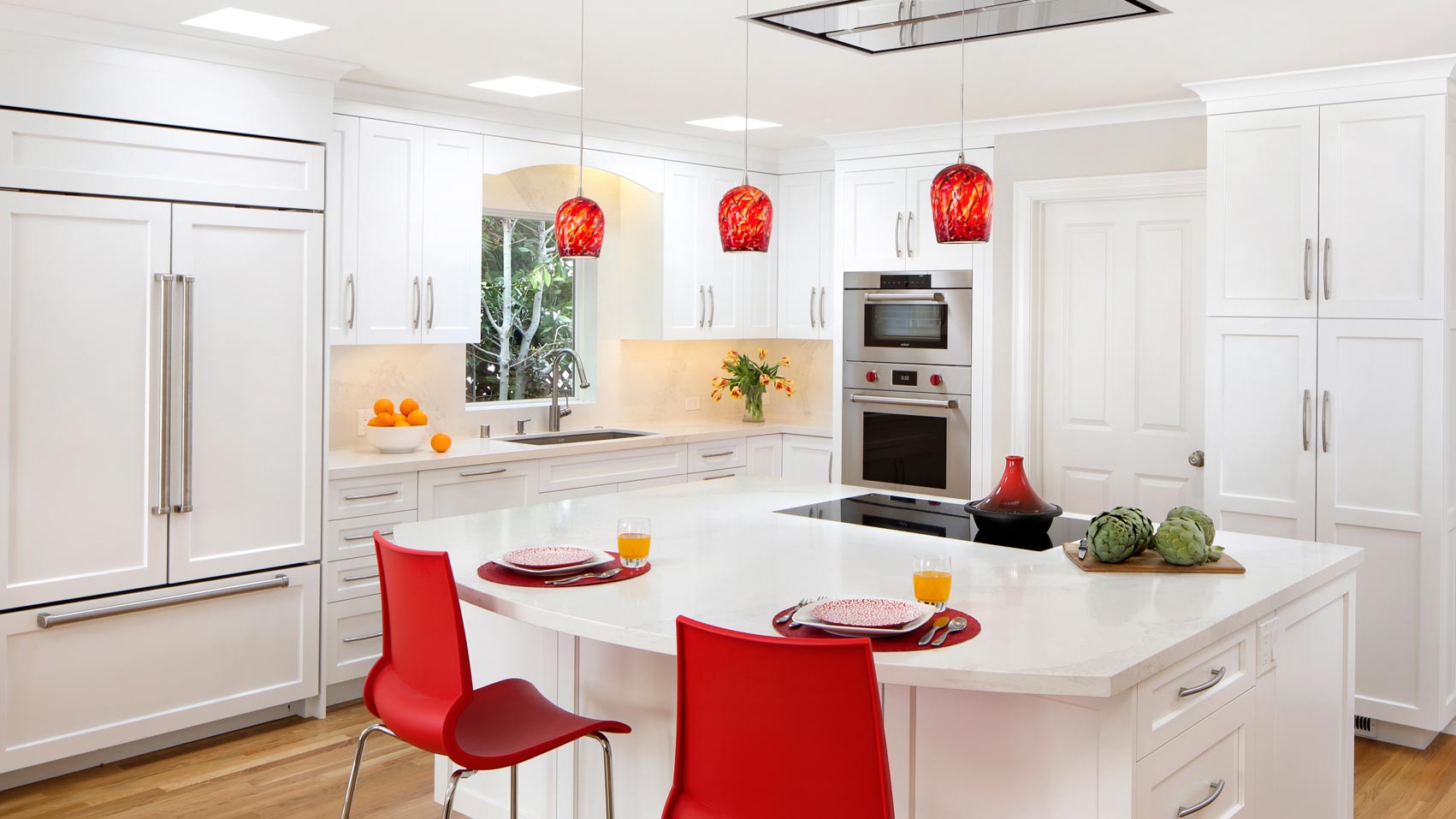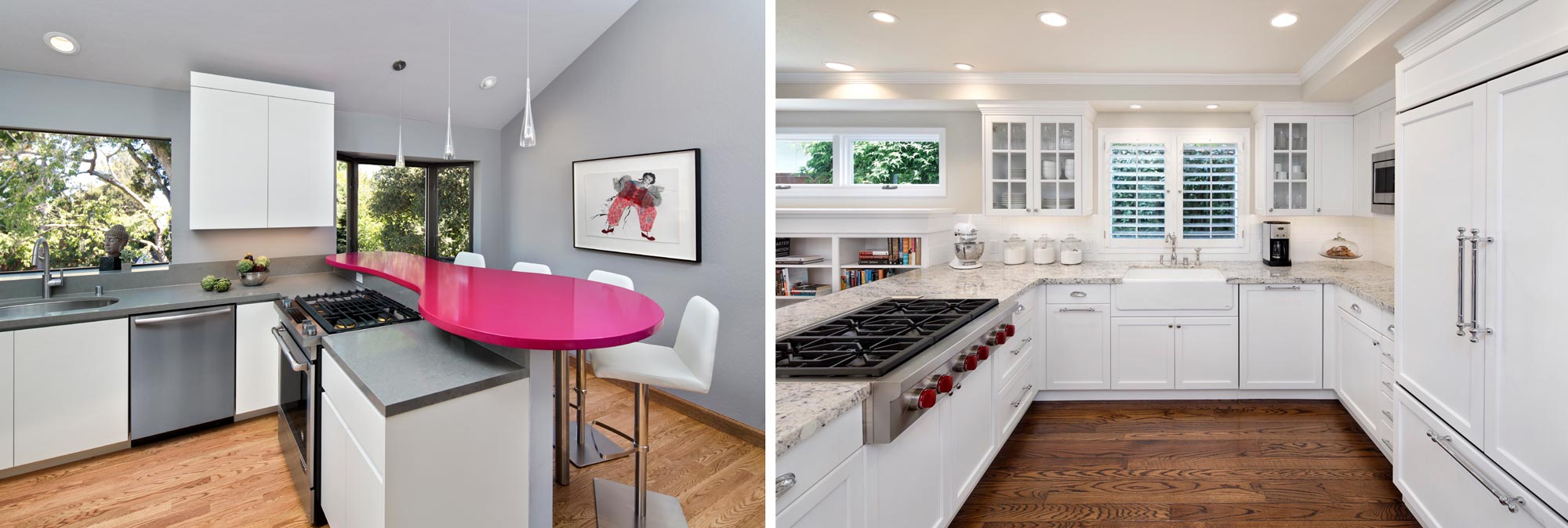Peninsula vs. Island: How to Know Which Works in Your Kitchen
The kitchen is the heart of the home. So much happens in this space: creating and eating meals, entertaining groups, chatting with a friend over a cup of coffee, doing homework or catching up on emails. Having an area that invites multiple uses is an attractive option and that’s where peninsulas and islands shine.
If you’ve decided to remodel your kitchen to meet your family’s lifestyle, there are a lot of exciting design decisions to be made to achieve a space that is both beautiful and functional. Certified Kitchen and Bath Specialist and Harrell Design + Build designer, Debra Winston, advises homeowners to carefully consider how they will use their kitchen.
Interested in a kitchen remodel? Harrell Design + Build can help!
One of the key decisions is whether your new kitchen layout will benefit best from an island or a peninsula. A peninsula extends out from an existing wall or counter while an island stands alone in the kitchen. Islands fit perfectly into an open floor plan, creating a break in a large space without providing a clear border. A peninsula, on the other hand, creates a definitive border between your living space and cooking area.
Islands
People are drawn to an island. It is a fantastic place to entertain and interact with guests, keeping them on the periphery if you’re cooking. But Debra explains that an island does have certain requirements to make it functional.
- Enough space: Ensure there is at the bare minimum 3 feet—four or more is better—around all sides for proper traffic flow.
- Just the right size: Too large of an island can make for an inefficient space. It is important not to have the island block the “work triangle,” the pathway between the sink, refrigerator, and cooktop. It can become an obstacle (or a race track) if you have to walk around the island every time you have to grab something from the refrigerator and rinse it at the sink. If you put a prep sink in a large island, this can be a way of creating a secondary work triangle, alleviating the race track feeling. An island that is too small lacks usable counter space for just about any purpose.
- Additional seating: Many families sit at their island to eat meals, saving the dining area for more formal events. An island should be large enough to seat two to four people comfortably, with seats tucking away when not in use. If you are lucky enough to have the space, five or six seats could be possible with the right planning. Allow two feet per seat/person at the island.
- Sink or cooktop: A secondary sink in the island can be useful for food prep or for a beverage center with filtered, chilled, and carbonated water. Other people prefer a cooktop in the island so they can see into other rooms while preparing meals. If choosing the cooktop, the island should be wide enough for safety. The other thing to consider with this option is the vent hood location. If located in the ceiling above the cooktop, it can obstruct your view.
- Extra storage: Islands offer a significant amount of additional storage.
- Appliances: People who entertain or have large families may benefit from a second dishwasher in the island, especially if they’ve opted for a prep sink. Wine/beverage refrigerators are the perfect place for grab and go drinks and to chill your wine to perfection. Microwaves installed in cabinets allow young children to easily heat food without getting underfoot.
- Proper lighting: Pendant lighting lends itself well to islands, illuminating the space for baking, meal prep, or casual dining. Skylights also work well above islands and offer beautiful natural light.
- Universal Design: Having two different counter levels, one at the standard 36 inches and another connected counter at 30 inches extends the island’s functionality to those who require the use of mobility devices. And, if you enjoy baking, having a lower countertop is ideal for kneading doughs as well as a secondary workspace.
- Multi-Level: Some people like to have an area at bar height (42”) to create a visual barrier between the public view of a great room and the messier prep area on the island.

Peninsulas
Years ago, the peninsula held court in many kitchens. It worked well if your kitchen was long and narrow and that basic principle hasn’t changed. Though most homeowners lean toward a love of islands, a peninsula can often fit the same needs in kitchens that don’t offer enough room for their four-sided counterpart.
- The work triangle: If an island will interrupt the functionality of the work triangle (location of sink, oven, and refrigerator), a peninsula may be the answer. Dividing this triangle should be avoided as it detracts from the livability and overall design of the kitchen while a peninsula opens up the inner area of the kitchen, creating a continuous workspace.
- Seating: A peninsula offers extra seating for eating, entertaining, and checking those work emails. As with an island, the seats should tuck under the counter.
- Extra storage: Peninsulas can incorporate extra storage, and if they are deep enough, you may be able to get cabinets on the kitchen side as well as on the side with the seats.
- Multi-level counters: Peninsulas can also accommodate two-level counters but in a different format. “By having the seating counter at a height of 42 inches, it also serves to hide the “mess” in the kitchen,” says Debra of the benefit of peninsulas.
- Electrical: By code, both peninsulas and islands must have electrical. This also makes them more functional for working, using countertop appliances, and charging devices.
- Lighting: Proper illumination is always a must. Pendants are a great option and visually define the space.
“One thing to remember is that both islands and peninsulas require proper clearance for passage behind someone who may be opening a nearby appliance, such as a refrigerator, oven, or dishwasher,” cautions Debra. “This is one of the many things we as designers think through in advance as we are designing a kitchen remodel.”
Peninsulas and islands both have their benefits and add to the beauty and functionality of a home. For kitchens that aren’t spacious enough for an island, a peninsula can be a fantastic option that is both functional and adds a wonderful design aesthetic to your newly remodeled space.
Is it time for your kitchen to get a much-needed makeover? Book a complementary design consultation at either Harrell’s Los Gatos or Palo Alto showrooms. Designing and remodeling distinctive homes since 1985, Harrell Design + Build serves homeowners in Silicon Valley and the San Francisco Bay Area.
Debra has been with Harrell Design + Build Design + Build for five years. She has a Bachelor degree in Fine Arts, is an accomplished painter and quilt artist, and spent 13 years working for Ralph Lauren in New York City as a fashion designer before moving to California. She studied Interior Design at Cañada College, where she specialized in Kitchen and Bath Design. Debra worked as an Interior Designer prior to joining the Harrell Team in April 2014. Debra has received numerous awards for her designs, her specialty being Kitchen and Bath redesign, as well as color consultation. Debra is a passionate Universal Design Certified Professional (UDCP), and also works on whole-house remodels and room additions.












